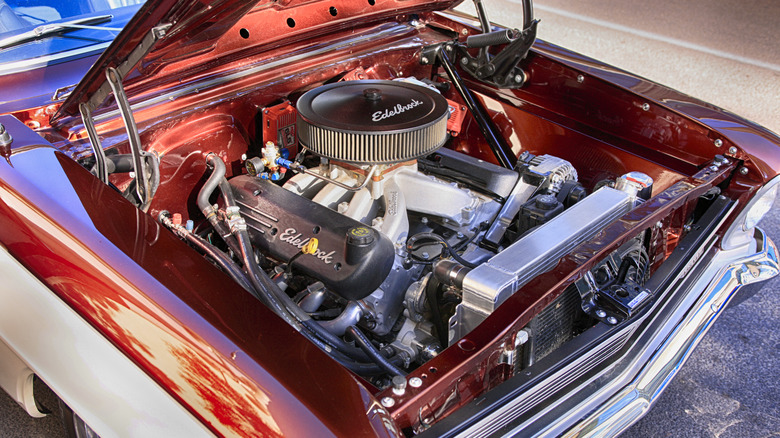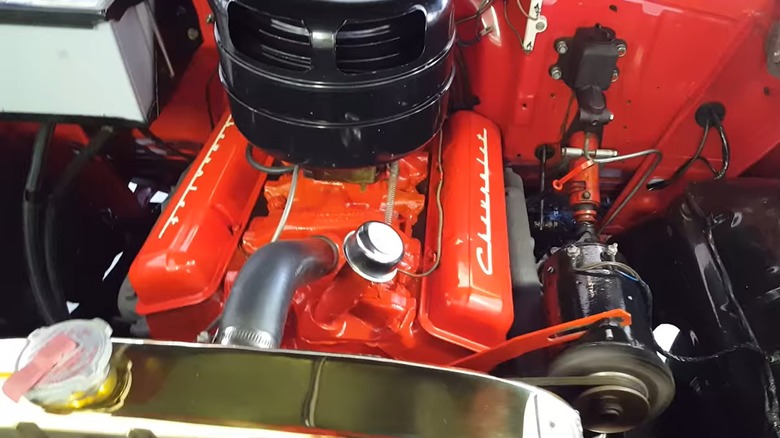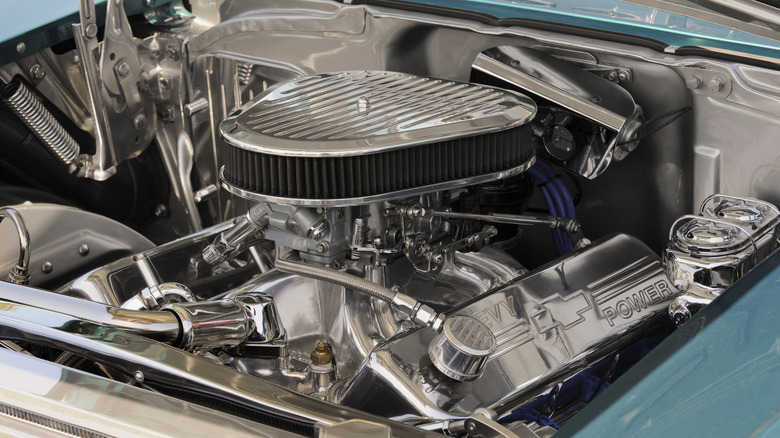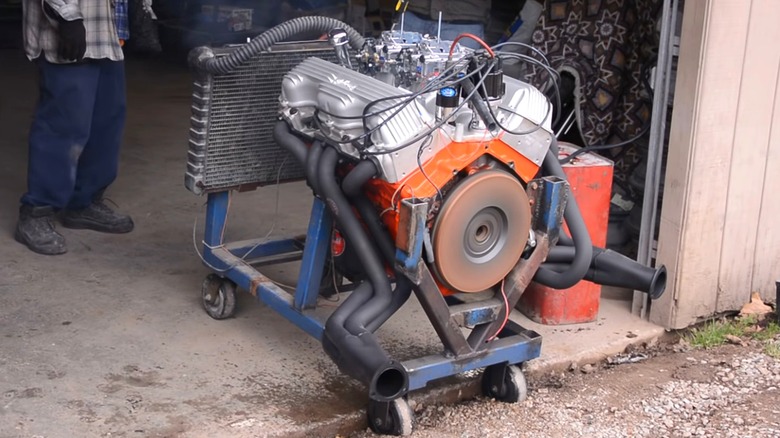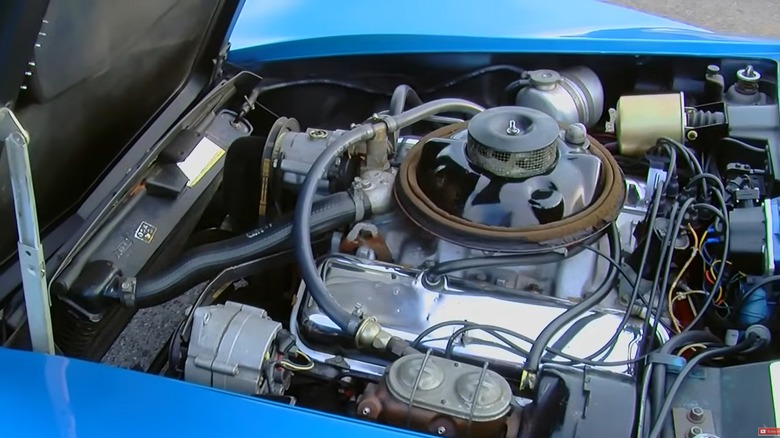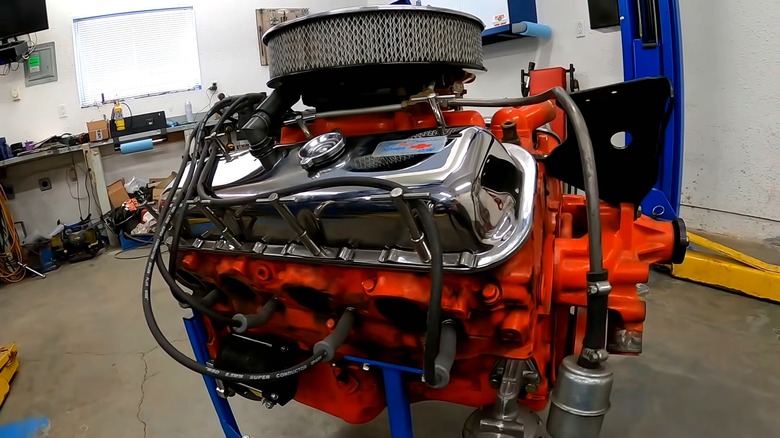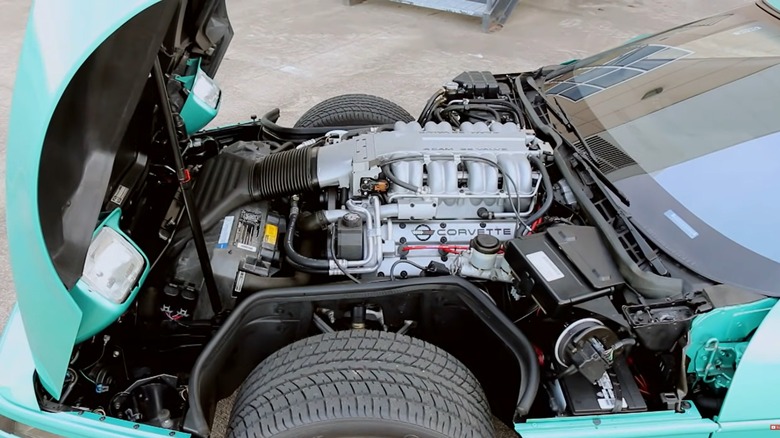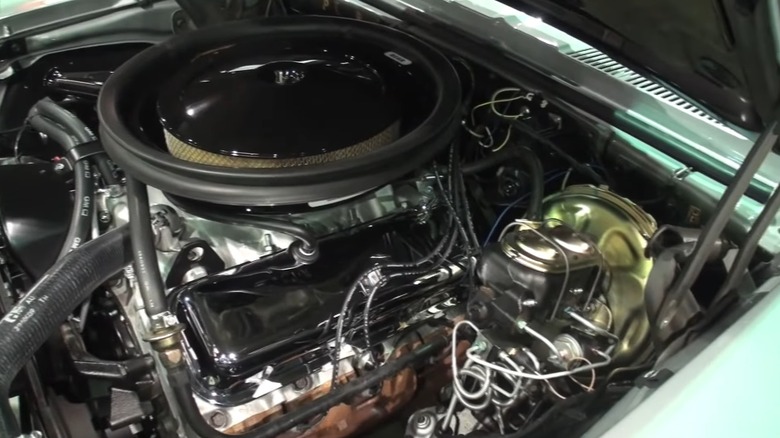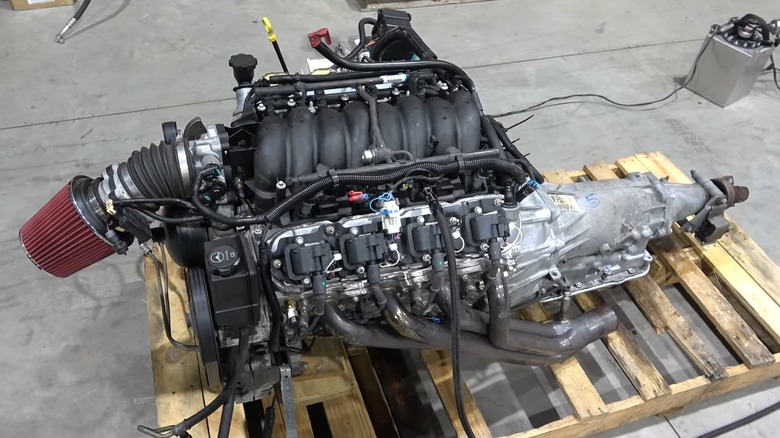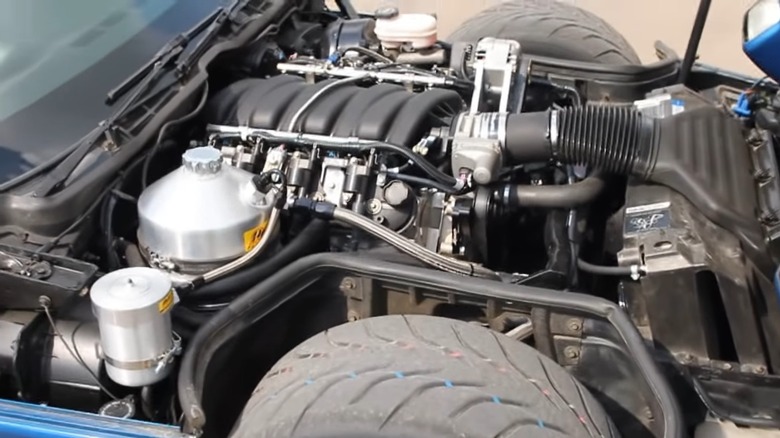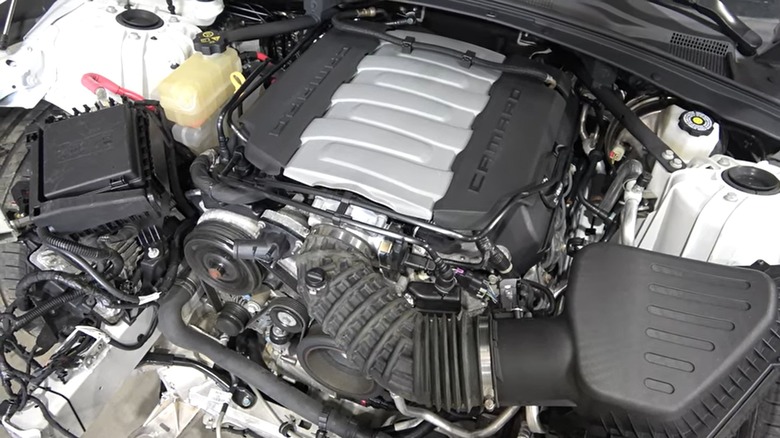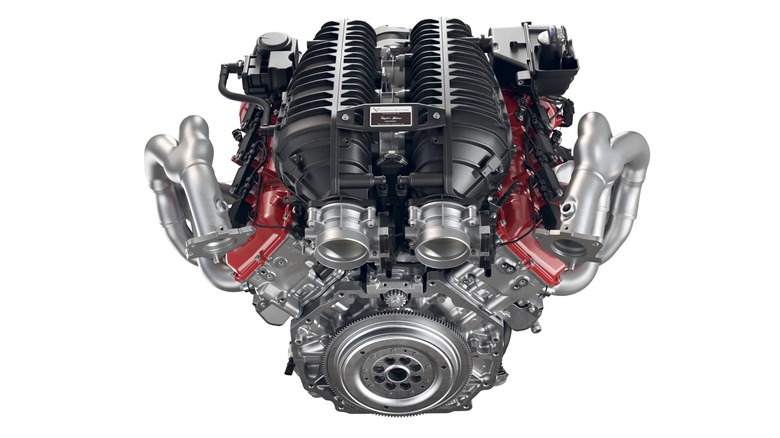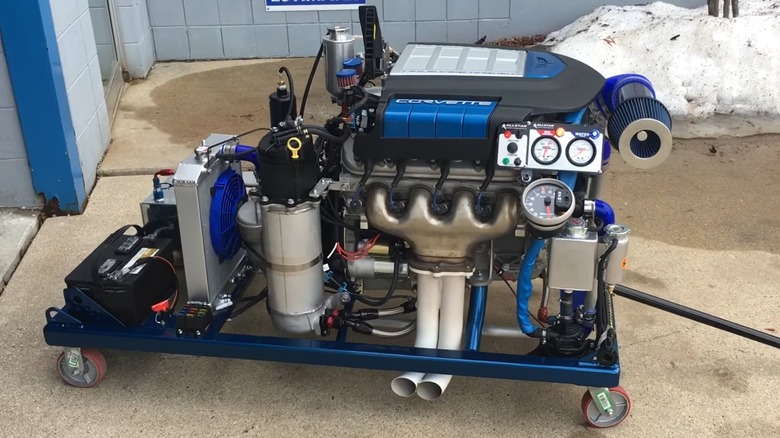12 Of The Best Chevy V8 Engines Ever Produced
Although Chevrolet developed a V8 engine as early as 1917, the company really made its mark with the small block V8 in 1955. Just three years later the automaker introduced the powerful 348 ci engine followed by the 409 ci mill, beginning a long series of high-performance small-block and big-block V8s.
Chevrolet has manufactured many powerful and reliable V8 engines over the years. One of the most influential was the small block Turbo-Fire 327 ci engine. The high-performance version powered the Corvette and Camaro, while the base engine was used in Chevy's family vehicles and trucks. Although it had limited production from 1962 to 1969, the engine was installed in dozens of GM vehicle models during the period, and it was used in additional domestic and foreign applications. American companies such as Studebaker and Checker Cabs used the 327, as did the English car manufacturer Gordon-Keeble, the Italian ISO Rivolta, and Holden of Australia.
For the 2009 model year, Chevrolet offered another small-block performance engine, the 6.2-liter LS9 V8 in the Corvette ZR1. The Roots-type supercharger helped make it GM's highest-performance production engine to date. Since then, the engine has also been used by other high-performance vehicles, such as the Equus Bass 770 and HSV GTSR W1. Furthermore, today garage mechanics can still order the crate version from Chevrolet Performance, albeit at a hefty price. While there are many to choose from, we've put together a list of the 12 best Chevy V-8 engines ever produced.
Chevy 265 Cubic Inch Small Block V8
Introduced as a 265 cubic inch V-8 in 1955, the Chevy small block engines powered Chevrolets through the 1950s and 1960s, with the 305 and 350 cubic inch versions showing up more in the '80s. The engines were powerful, easy to repair, and had ample parts availability for both professional and garage mechanics.
Perhaps the most significant impact the 265 V-8 had on GM automobiles was its contribution to the success of the Corvette. When Chevrolet introduced the first All-American sports car in 1953, it displayed a disappointing performance with the 235 ci six-cylinder "Blue Flame" engine generating only 150 hp.
However, Zora Arkus-Duntov, an engineer and avid racer, convinced GM executives to upgrade the newly released 265 V8 and offer it as an option for the Corvette. Arkus-Duntov designed a new high-lift camshaft, known as the Duntov Cam that added 33 hp to the 265, increasing the engine output to 195 hp. Chevrolet also incorporated other technological innovations in the 265 such as a valvetrain built with independent rocker arms — each of which was retained by an individual fulcrum ball and locknut — rather than the typical single rocker shaft.
Chevy 327 Cubic Inch V8
In 1962, Chevrolet introduced the 327 ci, small-block V-8. Based on the same architecture as the 265 ci and 283 ci small blocks, the cylinder bore diameter of 4 inches and a stroke of 3.25 inches increased displacement and provided more power for the heavier Chevrolet cars produced at the time and enhanced performance for the Corvette.
GM engineers also modified fuel delivery and induction to boost power. They revised the Rochester fuel injection system to enhance air and fuel volumes providing a more responsive throttle. The automaker installed the high-performance Duntov camshaft in all top-end Turbo Fire V8 small-block engines. While the base model 327 produced a compression ratio of 10.5:1, the more powerful version featured an 11.25:1 compression ratio.
While most of the engines were fitted with four-barrel carburetors, Chevrolet used Carter carbs on the lower-performing base models and the higher-end Holley carbs on the higher-performing L76 and L79 versions. The L84 installed in the Corvette was the only engine with a fuel injection system. The 327 cubic-inch V-8, fitted with the Duntov camshaft, produced 340 HP at 6,000 RPM and 344 lb-ft of torque. When the Rochester fuel injection system was added, the engine generated 360 hp at 6,000 rpm and 352 lb-ft of torque at 4,000 rpm.
A Corvette equipped with the more powerful 327 ci engine accelerated to 60 mph in 5.9 seconds and reached the quarter mile in less than 15 seconds at just over 100 mph.
Chevy 409 Cubic Inch V8
The 409 is best known for its performance on the drag strip and in '60s street hot rods as described in the classic Beach Boy's song "409." The 409 ci engine began with the 1958 348 ci W-Series engine, which was designed to meet the demands of heavy-duty trucks towing big loads. At the same time, domestic passenger cars were growing in size and weight, reducing the effective performance of the 283 CID V8.
The stock 348 in a passenger car mated to a two-speed Powerglide automatic transmission produced disappointing performance results. However, the same engine fitted with a high-lift camshaft, more compression, and tri-power induction connected to a manual transmission produced more than 300 hp. The enhanced 348 met with success on the racetrack, but it was the 409 that truly shone. The high-performance version produced from 1961 to 1965 was a 348 bored and stroked to 4.312 inches by 3.50 inches for increased displacement and larger head ports that provided a better fuel and air mixture volume.
Although it was held back from success in NASCAR long-track competition due to cylinder head and combustion chamber design using heavy pistons, on short runs the 409 was a star. The Chevy 409 engine became the go-to powerplant for U.S. drag racers in the early '60s and for many regional racers in the mid-'60s. Some of the most famous racers included Dyno Don Nicholson, Dick Harrell, and Hayden Proffitt.
Chevy L88 427 Cubic Inch V8
In 1967, Chevrolet built 20 Corvette L88 models equipped with the RPO L88 race engine, developed by the esteemed engineer Zora Arkus-Duntov, rated at only 430 hp at 5,200 rpm. The engine had the same displacement as the L71 engine but with some significant power-enhancing upgrades. These included Can-Am spec aluminum heads, a strengthened crankshaft, a solid lifter, 12.5:1 compression-rated pistons, cold air induction for more oxygen per air volume, and an 850 CFM Holley carburetor.
However, at 7,400 rpm, the L88 V-8 produced 550 hp, and even more impressive, generated a remarkable 600 hp using high-octane racing fuel with the exhaust removed. The output was more than sufficient to power the racecar to the quarter mile in about 11 seconds and take a victory lap for winning in its class at the 1967 Sebring 12 Hours. The 1967 Vette, which was equipped with the L88 engine mated to a heavy-duty four-speed manual gearbox, a tuned high-performance suspension, robust vacuum-assisted racing brakes, and a Positraction rear differential, set a speed record of 171.5 mph on the Mulsanne straight at the 24 Hours of Le Mans.
The L88 Corvette was so powerful Chevrolet even advised drivers against taking the car on the street. Chevrolet offered the L88 engine from the factory only in a Corvette but also made it available to buyers from the parts counter.
Chevy 454 Cubic Inch LS6
The year 1970 represents the pinnacle of the muscle car era and the production of big-block, high-horsepower engines in American cars. Chevrolet had established a track record of successful powerplants including the innovative 396, the dragstrip and street rod 409, and the notorious L88 powerplants. These competed well with the likes of the 375-hp Super Cobra Jet 429 ci big-block equipped Ford Mustang, the 1970 Challenger R/T fitted with the big block 440 Magnum, the Plymouth Superbird powered by a 426 HEMI big block V8, and others.
However, of all the muscle car powerplants available in 1970, Chevrolet's 454 ci LS6 rose to the top. The automaker offered the big block engine in three versions, but the LS6 was the high-performance engine of choice for the El Camino, the Chevelle, and — in 1971 only — the Corvette.
The LS6 featured a high compression ratio of 11.25:1, with a solid lifter camshaft as opposed to the hydraulic lifters on the LS5. In addition, the engine was fitted with rectangular port heads with a 2.19-inch intake opening, a 1.88-inch exhaust opening, forged aluminum pistons, and a massive 800 cfm Holley carburetor. GM rated the output at 450 hp, though it was lowered to 425 hp in the Corvette. However, many muscle car enthusiasts believe the automaker underrated the power to keep insurance premiums reasonable. Test results for the SS454 Chevelle showed quarter-mile runs of 13.2 seconds with a four-speed transmission and 13.8 seconds with an automatic.
Chevy LT5 350 Cubic Inch V8
Chevrolet manufactured the 350 small block V8 in 17 versions during its 35-year production run since its introduction in 1967. The Camaro SS, Chevelle SS, and Corvette ZR-1 were perhaps the best-known vehicles equipped with 350 small block power, but it was also seen in sports cars, muscle cars, SUVs, economy sedans, vans, and even trucks. The Chevy 350 was a naturally aspirated V-8 with models that used carburetors or fuel injection. The blocks and heads were made with either cast iron or aluminum, and a compression ratio that varied from 8.5:1 to 11.0:1. The power output varied from 145 to 370 hp and from 220 to 350 lb-ft of torque.
During the 1970 oil crisis, emissions restrictions significantly impacted power output, and auto manufacturers were required to label engine power output in terms of SAE net instead of SAE gross figures. This meant that the most powerful 350 engine ratings plummeted by 150 hp. In 1975, the LM1, Chevy's most powerful 350 engine produced a paltry 155 hp.
In 1990, things turned around when Chevrolet introduced the LT5. Designed in cooperation with Lotus and manufactured by specialty builder Mercury Marine, the LT5, an all-alloy dual-overhead cam V-8 that generated 380 hp at 6,200 rpm, is considered by many to be one of the best Chevy 350 engines ever built. The ZR1 powered by the LT5 accelerated to 60 mph in 4.5 seconds and achieved a top speed of 175 miles per hour.
Chevy ZL1 427 Cubic Inch V8
In the late 1960s, Chevrolet created the Central Office Production Order (COPO) allowing dealers to order cars with a mix of parts and options. The 9560 COPO package came with an L78-equipped Camaro, but it could be ordered with the 427 ZL1 and other accessories making the car ready for racing. Features included the F41 suspension composed of heavy-duty shocks, special front and rear stabilizers, special springs, and rear axle control arms. The 9560 COPO Camaro also had a larger radiator, a cold air induction cowled hood, front disc brakes, a 4.10 rear gear with a limited-slip differential, 14×7 wheels, and shipped without a radio to save weight.
Built with an aluminum block and heads, the ZL1 engine had a factory output rating similar to the powerful L88 of 430 hp at 5,200 rpm and 450 lb-ft at 4,400 rpm. However, dyno tests of factory ZL1s have confirmed an output closer to the 550 hp range, making it the most powerful engine offered by Chevrolet in a production car. The lightweight engine tipped the scales at 500 pounds, about the same as the Chevy 327 ci V-8.
Chevrolet produced only 69 Camaros fitted with the ZL1 427 V-8. The engine upgrade price of $4,160, which was almost double the price of a base model V-8 Camaro at $2,727, discouraging most potential buyers who were reluctant to shell out over $7,000 for the car and taxes. According to Motor Trend, Chevrolet produced only two ZL1 Corvettes, but the rumor is that several pilot cars were also made during the development process.
Chevy 5.7L LS1 V8
General Motors first produced the third-generation small block 5.7L LS1 V-8 engine in 1997 for several high-performance cars as a replacement for the LT1 engine. Both the Camaro and the C5 Corvette were equipped with the LS1 engine that included several key design elements.
These included all-aluminum construction featuring a cylinder block with a 90-degree cylinder angle and bore and stroke dimensions of 3.90 inches and 3.62 inches, respectively. The Gen III block hosted a rotating assembly of a cast iron crankshaft and 6.1-inch-long, powder-metal I-beam design connecting rods, M142 hypereutectic cast aluminum-alloy pistons, and a hydraulic roller-lifter camshaft still located in the engine block. All Gen III engines featured a port-fuel injection system and a coil near-plug ignition.
Chevrolet introduced the LS1 in the 1997 Chevrolet Corvette C5 and continued its use through 2004. Rated at 345 hp at 5,600 rpm and 350 lb-ft of torque at 4,400 rpm, the Vette accelerated to 60 mph in 4.72 seconds with a manual transmission and 5.05 seconds with an automatic. The car reached the quarter mile in 13.36 seconds at 109.4 mph and achieved a top speed of 172 mph.
Chevy 7.0L LS7 V8
In 2006, Chevrolet developed the LS7 7.0-liter engine to power the Corvette C6 Z06, 427 Convertible, and the fifth-generation Camaro Z/28. With an output of 505 hp, it was the most powerful naturally aspirated engine in Corvette history at the time. Each LS7 was assembled by hand, which contributed to the engine's notoriously consistent and smooth power delivery.
GM developed the lightweight LS7 block using data acquired in GM's racing programs. The automaker installed pressed-in steel cylinder liners required for the engine's large diameter cylinder bores (4.125 inches) and durable, six-bolt, cross-bolted forged-steel main bearing caps to maintain the balanced crankshaft, reduce crank flex, and contribute to a stiff engine structure. A racing-style dry-sump oiling system ensures proper oil pressure and lubrication during extended high-rpm use and high-load cornering. The LS7 also uses lightweight titanium connecting rods to minimize the pressure on the rod end bearings and the main bearings and reduce weight.
To optimize the power output of the large displacement, 11.0:1 compression ratio engine, the LS7 also employs high-flow cylinder heads developed from racing heads first proven on the track by the Corvette Racing team. An Advanced Electronic Throttle Control (ETC) delivers exceptional throttle response and better reliability than a mechanical system. Car and Driver tests of the 2006 Z06 Corvette showed an acceleration from 0 to 60 mph in a mere 3.6 seconds, 100 mph in 7.9 seconds, and 150 mph in just 17.5 seconds.
Chevy 6.2L LT1 V8
Part of GM's Gen V Small Block engine family, the 6.2 liter V8 LT1 engine producing 460 hp first appeared in the 2014 C7 Corvette Stingray followed by the sixth-generation Chevrolet Camaro beginning in 2016. The Gen V aluminum cylinder block features a 90-degree cylinder angle and bore and stroke dimensions of 4.06 inches and 3.62 inches, respectively. An oil-spray piston cooling system provides unparalleled lubrication and cooling by drenching the underside of each piston and the surrounding cylinder wall with a layer of friction-reducing oil.
The rotating assembly in the block features 6.1-inch-long powder-metal connecting rods with a new profile to enhance strength and a steel crankshaft. High-strength nodular main bearing caps absorb vibrations and other harmonics to promote a smooth and quiet performance. The engine includes a dual-equal camshaft phasing feature controlled by the Active Fuel Management system to maximize performance under a variety of conditions and enhance fuel economy.
An electronically controlled throttle provides durability and enhanced control. The Gen V performance is achieved with an advanced crankshaft position encoder providing ideal ignition timing. The 2014 C7 Corvette Stingray equipped with the 6.2L LT1 V8 produces 455 hp and 449 lb-ft of torque while it accelerates to 60 mph in 3.7 seconds before reaching the quarter mile in 11.5 seconds at 120.5 mph and ultimately achieving a top speed of 190 mph.
Chevy Z06 LT6 V8
Chevrolet manufactures the production version of the LT6 with the same cylinder block, heads, valvetrain, and fuel system design used in the racing version, the LT6.R. Only minor changes for emissions systems and adjustments to improve reliability distinguish the road version from the race engine. However, the LT6 produces more power than the LT6.R since it is not subject to racing restrictions.
Several features help the LT6 achieve its top position as the world's most powerful naturally aspirated production V-8. When installed in the Corvette Z06 the mill produces 670 hp at 8,400 rpm and 460 lb-ft at 6,300 rpm, blowing away the 2014 Mercedes-Benz SLS AMG Black Series equipped with a 622 hp 6.2-liter M159 engine.
Several factors allow the LT6 to produce its remarkable power. Perhaps the two most important are the well-designed cylinder heads and flat-plane crankshaft design. The engine features a dual-overhead-cam system with independent hydraulic camshaft phasing that controls two cams per engine bank. Although the flat-plane crankshaft tends to vibrate, the benefits outweigh the inconvenience. The forged-steel LT6 flat-plane crankshaft is significantly lighter than the crankshaft used in the standard C8 Corvette engine resulting in faster rpm variation and more resistance to high rpm failures.
Other features that help augment the LT6 power include two large throttle bodies providing high-capacity air volume. Resonance supercharging occurs when the 32 individual intake valves slam shut, providing an extra air boost. Six-bay oil scavenging, a system borrowed from Chevrolet's racing motors, keeps the engine well lubricated under the most demanding driving conditions.
Chevy LS9 376 Cubic Inch V8
Although General Motors faced a financial crisis in 2008, the company never gave up on the Corvette and the automaker's plans for development remained ambitious. Chevrolet engineers knew they needed to outfit the new ZR1 with a more robust engine than its high-performance sibling, the Z06. The result was the LS9, one of a handful of GM engines assembled by hand.
At the heart of the LS9 is a 319-T7 aluminum block built to weigh nearly 100 pounds less than comparable cast-iron blocks. Chevy engineers also made the engine more robust to tolerate the additional stresses created by the forced induction turbocharger system. The engine is designed to provide the best possible seal between the engine's piston rings and cylinder bore. Polymer-coated forged 9.1:1 compression-rated pistons, riding on titanium connecting rods connect to a dropped-forged micro-alloy steel crankshaft. In addition, the cast-iron cylinder liners with a deep-skirt design helped reduce vibration under more extreme operational loads.
The 2.3L Roots-style supercharger, a 4-lobe design that tops out at 15,000 rpm, helps the LS9 produce exceptional power. The engine generates 638 hp at 6,500 rpm, 604 lb-ft of torque at 3,800 rpm, and accelerates to 60 mph in only 3.4 seconds. The LS9 is also available from Chevrolet Performance Parts as a crate engine for an MSRP of $26,403.
